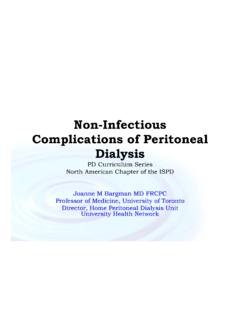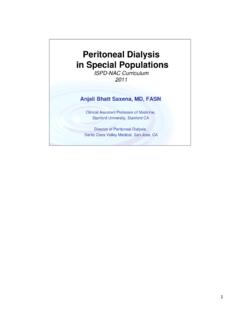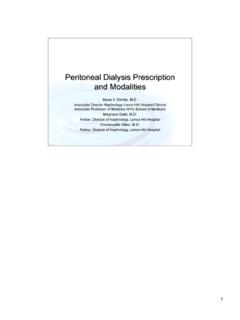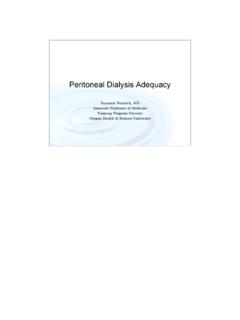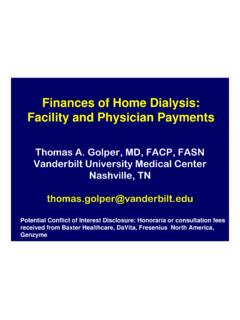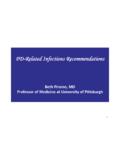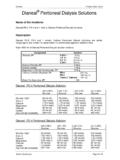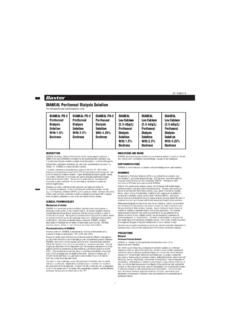Transcription of Encapsulating Peritoneal Sclerosis (EPS)
1 Encapsulating Peritoneal Sclerosis (EPS) Joni H. Hansson1 Scott F. Cameron1 Zenon Protopapas1 Rajnish Mehrotra21 Hospital of Saint Raphael/Yale University, New Haven, CT2 Harbor-UCLA Medical Center, Torrance, CA1 EPS: Outline Definition and epidemiology Clinical presentation Imaging Pathology Treatment Outcomes Summary 23 Encapsulating Peritoneal Sclerosis (EPS) Rare complication but serious complication of Peritoneal dialysis (PD): First described in 1980 (1) Incidence varies between to (2-8) Associated with significant morbidity and mortality Many present after PD has been discontinued The diagnosis requires both the.
2 Clinical features of intestinal obstruction or disturbed gastrointestinal function Evidenceof bowel encapsulation either radiologically or pathologicallyISPD guidelines from 2000 (2), felt the term Encapsulating Peritoneal Sclerosis (EPS) more accurately described the morphologic changes seen in this disorder. Other terms used to describe this entity include (8,9): Peritoneal fibrosis Peritoneal Sclerosis Sclerotic thickening of the Peritoneal membrane Sclerotic obstructive pertonitis Calcific peritonitis Encapsulating peritonitis Peritoneal chronica fibrosa incapsulata Abdominal cocoon Sclerosing peritonitisIncidence of EPSSCOTLAND1238 pts (1/1/2000-12/31/2007) 46 cases8-year cumulative incidence, and New Zealand7618 pts (1/1/1995-12/31/2007)33 cases8-year cumulative incidence, et al, Clin J Am Soc Nephrol 2009; 4: 1222-9 Johnson et al, Kidney Int 2010; 77: 904-12 The incidence of EPS varies across the globe.
3 It has been reported to vary between to for patients maintained on PD for 5 8 years. Factors that may contribute to this variation in the published literature include: patient numbers in the study, single center vs registry data, retrospective vs prospective, prevalent vs incident patients, criteria to establish the diagnosis and potential true differences in incidence. However, the observed incidence of EPS increases across all studies with length of time on PD. This slide demonstrates this in the ANZDATA registry (4) and Scottish Renal Registry (10) data. It should be stressed as reported in the ISPD position paper that most patients on PD for a long duration do not develop EPS (2).
4 4 EPS: Risk Factors The only consistent risk factor is durationon Peritoneal dialysis Other potential factors Glucose exposure Inflammation peritonitis Chemical exposure chlorhexidine Genetic factors Various other factors unrelated to Peritoneal dialysis5 EPS: Clinical Manifestations Symptoms of bowel obstruction Persistent/intermittent Partial/complete Abdominal pain/distention/nausea/vomiting Abdominal mass Hemoperitoneum Malnutrition and failure to thrive Ultrafiltration problemsThe symptoms of EPS can be vague, intermittent or chronic, and mild or severe. Kawanishi et al (11) proposed four stages of ESP: pre symptomatic; inflammatory; Encapsulating and ileus to potentially target therapeutic tactics for EPS.
5 Other disease processess need to be excluded that can present with similar symptoms. The clinical manifestations of EPS can also develop after the patient is transferred from Peritoneal dialysis to hemodialysis or after receiving a kidney transplant. Loss of ultrafiltration and an increase in Peritoneal membrane small solute transport has been found in many EPS patients, but this is neither sensitive nor specific. Thus, a constellation of clinical symptoms is not sufficient to make the diagnosis of EPS, but a high index of suspicion is required so an early diagnosis can be pursued. 67 EPS: Radiologic Manifestations Ultrasound Evaluation: Classical trilaminar appearance of the bowel wall with PD fluid in abdomen Abnormal small bowel peristalsis (small bowel dilation) Matted bowel loops with tethering to posterior abdominal wall Membrane formation anterior to bowel loops Loculated Ascites CT abdomen.
6 Isolated Peritoneal thickening or calcification is not enough Need to look for constellation of findings Diagnostic imaging modality of choiceCT Scan Findings in EPST arzi et alVlijm et alPeritoneal thickeningPeritoneal calcificationBowel wall thickeningBowel tetheringBowel dilatationLoculation (ascites) Peritoneal thickeningPeritoneal calcificationPeritoneal enhancementAdhesions of bowel loopsSigns of bowel obstructionFluid loculation/septationCT score 0-4 for each except bowel tethering and loculation (scored 0-3); range 0-22 Presence of three of above six itemsMedian score: pts, 9; PD controls, 1; HD, 0 Sensitivity, 79-100%; Specificity, 88-94%Tarzi et al, Clin J Am Soc Nephrol 2008, 3: 1702-10 Vlijm et al, Perit Dial Int 2009; 29: 517-22 Abdominal imaging has been used to confirm the diagnosis of EPS, however until recently there was no consensus on its specific radiologic abnormalities.
7 Two groups examined the use of CT findings characteristic for EPS and assessed the reliability and diagnostic utility of these findings (12,13). The scoring systems used in both studies were able to separate a significant difference between a higher score in patients with EPS from those of controls. However, some of the control patients on PD in both studies did have some of the CT findings considered characteristic of EPS. None of these controls went on to develop EPS . In Tarzi s study (12), the HD control group did not have any of the CT findings suggestive of EPS. It is of interest that the total CT scan score did not correlate with the clinical outcome in patients with EPS.
8 Another study looking at the incidence and experience of EPS in patients maintained on PD for >5 years from a single center in the US found CT abnormalities as described by Tarzi in 66% of patients with available CT scans (14). Only 10/25 of these patients had clinical symptoms of EPS. The other 15 patients did not develop EPS on follow up. These findings underscore the importance of utilizing the ISPD criteria (2,9) to diagnose et al (12) also examined available pre diagnostic CT scans done a median of years before the diagnosis of EPS was made. Pre diagnostic studies in 9/13 patients were normal or near normal. The next few slides are examples of the CT findings used in the above scoring systems.
9 8CT Findings of EPST hickened EnhancingPeritoneum (arrows)Loculated FluidCollection (arrows)Tethered small bowelLoops (arrows)Cameron et al: American Roentgen Ray Society Annual Meeting, 2010 In Tarzi s study (12), each parameter analyzed showed a significant difference between patients with EPS and controls. Bowel tethering and Peritoneal calcification were the most specific parameters. The presence of loculations was the least specific Findings of EPSD ilated and thick-walled loops of small bowel filled with fluid and oral contrast (arrows). Peritoneal thickening (arrow).Loculated fluid collections (arrows).Cameron et al: American Roentgen Ray Society Annual Meeting, 2010 10CT Findings of EPSB owel Tethering (arrow) Peritoneal calcification (arrow)Cameron et al: American Roentgen Ray Society Annual Meeting, 2010 11CT Findings of EPSV lijm et al, Perit Dial Int 2009; 29: 517-22 Tethered bowelLoops (arrows) Peritoneal Enhancement (arrow)In Vlijm s report (13) Peritoneal enhancement was found to be very specific for EPS.
10 Based on this, the authors suggested that a CT with contrast enhancement would be Pathologic Findings of EPSP eritoneal thickening (arrow) Peritoneal inflammatory changes (arrow) Peritoneal calcifications (arrow)Omental fat (arrow)Cameron et al: American Roentgen Ray Society Annual Meeting, 2010 Characteristic findings at laparotomy, laparoscopy or autopsy can range from the formation of a thin membrane on the visceral and/or parietal peritoneum to cocoon like encapsulation of the entire intestine found with advanced cases. Various degrees of Peritoneal thickening and calcification may be seen. Fibrous bands can form between loops of bowel.

